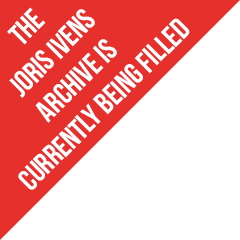

Why The Netherlands has so may outstanding painters and documentary filmmakers? German film historian Thomas Tode attempts – following previous authors - to provide an answer in a recent article. According to Tode it was Joris Ivens who was leading the way in depicting the elements of nature, like the famous Dutch Light, the wind or water in all its guises: rivers, rain and clouds.
This already started at the beginning of his film career with Études des mouvements à Paris (1927), The Bridge (1928), Breakers (1929), Rain (1929), We Are Building (1929) and Zuiderzeewerken (1930) and would continue to return in later films like New Earth (1933), Pour le mistral (1965) and A Tale of the Wind (1988). Similar to what his artistic predecessors already did in 17th century art.
It was not without reason that film historians discovered in the opening sequence of The Spanish Earth (1937) with the floating clouds influences of landscape painters like Jacob van Ruisdael. A reproduction of his painting The Mill near Wijk van Duurstede (1670) decorated Ivens’living room in Paris for decades. Ivens himself emphasized more than once that his inspiration didn’t derive from other filmmakers, but from the visual sensitivity of his painting colleagues from the 17th century, or from Brueghel and Van Gogh.
Dutch artists excelled because of ‘Der Beschreibung der Dinge’ (Hans Belting, 2013), a characteristic Svetlana Alpers already introduced in 1984 in her book about the Dutch Golden Age: The Art of Describing. Especially ‘Seeing’ the outer reality would have developed to a high level in The Netherlands because Dutchmen like Lipperhey, Jansen, Huygens and Van Leeuwenhoek invented and manufactured optical equipment with excellent lenses. Sharp, objective observation would result in a ditto registration and depiction of the physical world. Fortunately Tode could resist the tendency to limit this Dutch tradition to just ‘realism’ and explained that this realism certainly contained metaphysical levels of meaning as well.
German artist Joseph Beuys once gave a beautiful explanation for the existence the penetrating power of Dutch Light. The many water surfaces in the Dutch delta, the many lakes and rivers, functioned as a kind of enormous mirror, reflecting and strengthening its power. With the land reclamation after the new polders were created in the 1930s this reflection was reduced and the magical effects of Dutch Light ended.
Despite this Tode shows that since the Filmliga and film avant-garde in the 1920s and 1930s Dutch filmmakers produced a remarkable number of films in which, like in Ivens’s films, Dutch Light and other elements of nature are the protagonists: Gerard Rutten (Dood water, 1934), Herman van der Horst (’t Schot is te boord!, 1950/51), Bert Haanstra (Panta Rhei, 1951/52), Joop Huisken (ass-director, Lied der Ströme, 1953/54), Johan van der Keuken (De platte jungle, 1978) until Pieter-Rim de Kroon (Hollands Licht, 2003). A tradition which is almost lacking in the German film culture, according to Tode, because actors and feature elements are much more prominent.
However Tode wonders whether another element is at least as important in Dutch film & visual culture as this Dutch light and presumed realism: its international character. The Netherlands are such a small country that artists are forced to cross geographical borders as well as mental and cultural boundaries. Also in this respect Joris Ivens is again exemplary for many Dutch filmmakers of following generations. Ivens regarded the world as his film studio.
Tode’s article is part of a scholarly book about the relationships between Dutch and German film culture. He reveals also an 'unknown' contribution of Helen van Dongen in 1934 to a film of German artist and filmmaker Richter Daily Life. However: Bert Hogenkamp already mentioned the collaboration between Van Dongen and Richter in Ivens Magazine nr. 10 (2004), p. 23: '..she was fully occupied with the editing of Richter's film Daily Life (although it would remain unfinished).
Thomas Tode, ’Das Licht Hollands. Austausch zwischen niederländischer und deutscher Film-Avantgarde’, in Swenja Schiemann en Erika Wottrich (editors) Grenzüberschreitende Licht-Spiele
Deutsch-Niederländische Filmbeziehungen (München: edition text + kritik im Richard Boorberg Verlag GmbH & Co KG, 2021)